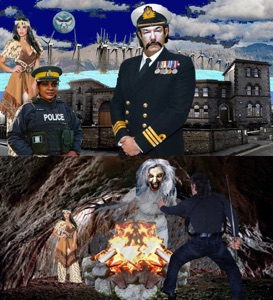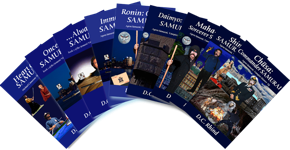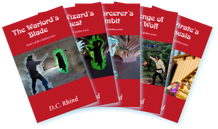.






Author’s Ramblings:
The author in the doorway to his new ‘dungeon’ office
- 2014 -
D.C. Rhind in dungeon doorway - 2020 -
It’s amazing how much of the writing process is intuitive, almost to the point that it writes itself. I have actually arrived at a place in the book where I’ve planned a character to do something, only to have another character do it. When I examine it, I find it just makes more sense the alternative way, yet it was something I never planned. Also, after introducing trivial events in the early and middle stages of a book, they sometimes come together at the end into something very important. Again, not planned, just something, possibly subconscious, that happens and works. No wonder the Greeks believed in muses.
I use Google almost constantly. Google Earth takes me places to which I can’t afford to fly. Google (web) provides me with climate info and all that trivial stuff like, Is there a cell phone jammer available to civilians? How many bullets will a Walther PPK hold? Google is also a fabulous, on the fly, spell-check. There, I’ve confessed.

For the sword-geeks, this is an actual combat katana, hand-forged, bimetallic (made of two different types of steel: mild for the body, folded around a high-carbon-steel edge). Unlike the pure stainless steel blades, they rust if not oiled. Also unlike the pure stainless steel blades, they don’t break. And they will break a stainless blade if you hit the stainless blade in the right manner.
The ‘fuller’ (some people call it a blood groove) allows the spine to be thicker without adding to the weight, making the blade stronger. Japanese masters knew this as far back as Muramasa Sengo in the 1500s.



I introduced the shirasaya in Immortal Samurai. It literally means “white scabbard” (invisible or hidden sword). They came into being during the samurai era, when only the samurai class were allowed to carry swords. Wealthy merchants commissioned swordsmiths to make some really good ones. This one is “practical” or combat-grade, like my katana, rather than stamped stainless steel.

Michael’s sgian dubh (skee´-an doo) deserve a mention. The outer two are more decorative and very slim, to be worn easily in a kilt sock. This also gives them better balance for throwing. They are sharp, but not meant to be utilitarian.
The center knife is much heavier, with an extremely sharp and very utilitarian blade. It is, however, useless for throwing unless you want it to hit hilt-first to knock someone out (which Michael did in one story).
Sgian dubh translates from Gaelic as ‘black knife’, black as in covert or hidden. The knife was originally carried under the armpit. When entering someone’s house, you would move it to the top of the sock so your host could see it. There’s no doubt that the blade was designed for stabbing. The edge is sharp enough to cut a throat, but the shape and strength of the blade make it ideal for severing the spinal cord with a thrust.
(Click to enlarge, new page)

(Click to enlarge, new page)
This is the second book in the series, but it’s actually the first book I wrote, originally “The Ice-Fire of Calebra” after the magical landia stone so central to the plot. I wanted to pit a young, totally untrained wizard against a frightening sorcerer so I created the character of Landon, a prince whose father refused to allow him to have wizard’s training. He’s the classic intelligent, over-achieving introvert. Knowing how young boys relate to larger than life heroes, Landon is just bursting with power that he can’t control – yet. Landon also has a mystery to solve, a foreign princess to meet in a lost kingdom, and, of course, his own kingdom to save.
As the concept of the series grew, I wanted the 3 heroes in the initial trilogy to deal with problems very differently. Landon is very much the liberal, even if he does occasionally get pissed of and have a go at magical violence.
To help hold the fort at home, I gave him a swashbuckling, extravert cousin, Narell. Narell is Captain of the King’s Guard. In these books, that corresponds to leader of the special forces. Narell is a master swordsman and martial artist – part ninja, part samurai. Experts in the art of Taelen, called vad-Taelens, are the stuff of legend, referred to as Warriors of Darkness.
In keeping with the genre, I threw in two romances, several showdowns where the bad guy gets walloped, son makes peace with father, and mysteries get solved.

When friends read “Ice-Fire of Calebra” (now “The Wizard’s Quest”), they began pestering me for the story of the warlord who destroyed the sorcerer Darios generations before. I didn’t really want to write it because I felt it was too linear. However, after a lot of thought and work, “The Warlord’s Blade” took shape. I wanted to make it a bit more tragic than “Wizard”, and did, but you’ll just have to read it to learn more. Once more, I created a mystery surrounding a traitor who is aiding the sorcerer.
From the outset, Valias was your typical conservative warrior type, in contrast to Landon’s more open-minded approach. That was part of the overall plan for the series.
I had great fun creating humour, like the wizard who is captured by the sorcerer and can only escape by passing through the barred window. The entire room is warded against magic. Step by step we watch him figure out how to change himself into a bird. But the wizard, who couldn’t fly, turned himself into a bird that couldn’t fly!
As the climax nears, I do my best to make things as tough as possible for the hero, keeping the possibility of failure in the forefront.
What I hadn’t counted on was the details of the ending. The muses were at work. Not only was it suddenly clear how the incompetent sorcerer was able to summon Darios in book 2, but I’d unintentionally created a situation making Darios’s return in the future inevitable. Uh-oh. Now I was stuck with having to write a third book!

I approached the third book with the desire to do something different. Wanting part of the story to pay homage to all those “Wizardry” and “Bard’s Tale” games I’d been playing on the computer,I gave the hero a reason to have to transit an underground maze filled with booby traps and puzzles. I also wanted the hero himself to be a mystery, a darker character, and a balance between Valias’s conservative warrior and Landon’s more liberal wizard. For a third of the book, Jaraden is a thief, possibly a murderer, definitely a renegade Warrior of Darkness. I’m also hoping that his true identity will be a shock, though all the hints are there.
As a side kick, I created a female warrior, trained by her vad-Taelen father. I played around with the psychology of an attractive tom-boy who has fought to create a place for herself in a male-dominated society. Then, when she meets the Prince of Klerandia, sent to find the mysterious thief, she falls in love with him and has to figure out how to be feminine without giving up the strong identity she’s created for herself.
Then there’s the conflict between Prince Kendar and our mystery man.
The final conflict: Sorcery is bad, outlawed. All sorcerer’s have been evil. And the only way mystery man can save the world from destroying itself is to become a sorcerer! Feeling sorry for Jaraden, I created a romance for him as well, just to complicate his life.

Just as I was getting used to the idea that “The Ice-Fire of Calebra” was a trilogy, two things happened. First, “The Wizard’s Quest” got picked up by an American publisher. That put me into rewrites and got me thinking about another book. Second, just as I was getting the idea of continuing the story of the hero of “Sorcerer,” 9/11 happened. I’d ended “Sorcerer” with talk of the new King of Palendar wanting to introduce some democracy into the kingdom in the form of an elected council. The atmosphere of terrorism did the rest. I wanted to pit one man – one very dangerous, very angry man – against the terrorists. I wanted to terrorize the terrorists. Enter The Wolf and another mystery man who survived an explosion that killed the entire Royal Family and any spectators too close to the explosion.
This became almost a detective story. In places I had the warlord playing Dr. Watson to the overlord of the wizards’ Sherlock Holmes. My favourite parts, though, were giving it to the bad guys in true morality play fashion.
As for The Wolf, I loved the idea of a dark hero, clearly filled with unresolved anger. Writing him was a great release — quite cathartic, actually. The question became: just how far to the dark side could I take him and still keep him a good guy?

My son, Sean, was working on his blue belt in Kung Fu (after that comes brown, then black), and it gave me the idea for yet another character. At the end of Revenge of the Wolf, the missing infant prince is whisked off on a ship which gets attacked by pirates. I’d already shown hints that there was something odd about him — he was born a sorcerer and can talk to ghosts in his head. Deposited on a jungle island (picture Hawaii or Tahiti a few hundred years ago), he grows up learning everything about his distant family, the martial art of Taelen, wizardry, and sorcery from spirits.
As he sets out to rescue his sweetheart, taken by a pirate captain who fancies her, Kadua-ka displays all the temper, know-it-all attitude, and impatience so typical of teenagers, and has to learn maturity along the way, especially when he becomes responsible for the teenage island warriors who insist on helping him.
Meanwhile, his real father, finally locating him, has to chose between stepping in and bringing his son home and giving him some room to act on his own. When father and son finally do team up, the bad guys are in big trouble.
Knowing this would be the last book, Kadua-ka’s talents made it possible to bring back ghosts of all the previous characters for a reunion of sorts. One evil-sorcerer-turned-good-guy still has a wicked sense of humour.

The Application of Science (and Pseudo-Science) to “Magic” in the Calebra Fantasy Series
When I began the Calebra Fantasy series, I couldn’t bring myself to describe wizards and their magic as anything other than having a scientific basis. The notion of any kind of hocus-pocus, incantations in Latin or Elvish, causing something mystical to happen just didn’t sit well with me. Thus, I had to devise the theory of a mineral that gave control over matter and energy to certain people.
I eventually wrote a paper on the subject which, in conjunction with another monograph (Speculations on Vampire Physiology and DNA), became the abstract premise for my Master of Arts in Creative Writing from Frontier University.

Once a Samurai ...
I wanted the irony of a vampire-hunter who was a vampire. Enter Lord Anthony Dewhurst, former colleague and cohort of Sir Percy Blakeney, The Scarlet Pimpernel. He’s been a member of Scotland Yard, MI6, and now works as a profiler for Interpol, specializing in profiling unusual serial killers. Most vampires try to live like normal folks, consuming bottled blood. Lord Tony specializes in tracking down and organizing the destruction of predatory vampires.
Problem: I just couldn't get into Tony's head and, as writer's say, "find his voice." I needed a different main character — a human. Before I was fully conscious of it, I created a character based on my own background — someone who had been a martial arts instructor, trained in swordsmanship — someone who had been through the wringer: boat sank, wife died, failed 2nd marriage, mother died (in my case it was my father), and his father, a retired detective inspector, dying of lung cancer. I wanted the character to be totally knocked off balance by the shock of: a) learning that vampires exist, b) learning this when he is attacked by one who was lying in wait to kill him personally (carrying a description of Michael, a description of his car and license plate number), and c) learning that Tony Dewhurst, who Michael has known since he was 13, is a vampire. As if that isn't enough, I hit him with nightmares that point to past-life memories as a 16th century samurai, hence the title, Once a Samurai ... And, of course, the sequel, completes the phrase: ... Always a Samurai.
So, having set out to have a vampire-hunter who was a vampire, I ended up with a vampire-hunter who was human, aided by a vampire, who would become one himself. The cool part was getting to watch him change over the course of two books. I also wanted to see if I could believably get away with a sword-wielding hero in the middle of the city.
No characters are truly based on real people. Michael shares much of my experience but goes far beyond anything I could claim to be. Carrie, a former ER RN, now working as a nurse in a retirement home, is loosely based on my wife Carol. Other characters are either fabrications or vaguely inspired by the personalities of real people, making it easier to keep their characters consistent and their dialogue unique. Samwise Gamgee (my Pembroke Welsh Corgi) and Kato (my Bluepoint Siamese Cat) pretty much play themselves. Sam was stolen, gone for 4 weeks until he came walking up the street, 8 pounds lighter, with a noose scar around his shoulder. During that month, I’d jumped ahead and wrote some of the climax. Thus, poor Sam, who was very much alive the the writing, met a nasty death in the book. Alas, in the fall of 2009, Sam’s age and associated infirmities caught up with him, and he died about a year later. Even Kato misses him. I’m currently revising the eBook text, removing a few areas that don’t help the plot advance, and incorporating some ideas that were developed further during the writing of Heart of a Samurai.

... Always a Samurai
In “Once a Samurai ...” Michael finds that his incredible speed is the result of Tony saving his life as a child by putting some vampire blood into a wound. This book starts with a flashback to a missing scene from book one, hinted at but never shown before, setting the premise for increased vampirism in Mike. Now, as the story unfolds, Michael is showing an increasing presence of vampire traits and fears that he may have little time left as a human.
CSIS wants Mike to go to Afghanistan to locate and rescue a missing agent. In addition to Carrie, Tony, and Nigel, (the cockney hacker and expert cracksman), I enjoyed creating a CIA agent patterned after Kelly Robinson from I Spy, one of my favourite TV shows as a kid. But nothing is what it seems. Nigel goes from ‘hobbit thief’ of book one to a collector of spy gadgets, at Lord Tony’s expense. In Tony’s words, “I’ve been rather loose with the budget in that area and, lately, you’d think I put him in charge of Q-Branch at MI6.”
I wanted to make “... Always a Samurai” more of a spy novel, and I wanted to make Mike’s constantly increasing vampire traits part of the plot. Halfway into the story, it became clear that Mike wouldn’t remain human much longer. AND, with the romance getting just a bit steamier, are there wedding bells in the future for Mike and Carrie?
When I wrote the final scenes, I was on a kind of high. The first few copies of Once a Samurai... had arrived and a photographer was coming over to take pictures for a newspaper article.

Immortal Samurai
Okay, Mike’s a vampire. Now that we’re over that – I liked how I started ...Always a Samurai so much that I decided to do the same thing in this book. I took events that began in the last chapter of Always (told from Carrie’s viewpoint) and retold everything from Michael’s perspective, right up to the last line of Always and beyond. Telling you anything more would give the ending of Always away. It’s clear now that a group of not-so-nice vampires want Mike dead. Having let Radu reappear at the end of Always, I decided to keep him around in this book. I also liked Sam Larkin enough to keep him around at the beginning. My wife is still helping steam up the romantic bits. (We must keep it PG-14, dear.) Nigel’s wife was starting to complain, so I had to let him stay in England for most of the book. An event in the story took me by surprise: Crystal’s character. I had one idea in mind, then another started writing itself. I never intended to create the possibility of Carrie eventually changing, but once that popped up, other notions became obvious, including the link to book one near the end. I’m also starting to like researching historical characters as potential vampires. I wanted to do a lot of things different in this book, but I also wanted to draw a few parallels, like a scene that’s a bit reminiscent of Van Helsing, Harker, Seward, Quincy, and Arthur Holmwood finding Dracula’s coffins in the cellars at the Abbey, but with some major twists. We also learn a bit more about vampire DNA.

Ronin: Outlaw Samurai
Before Immortal was finished and in rewrite, my thoughts were already turning to book 4. I always want to do something different. It occurred to be to bring Monahan back. I don’t think I’m through with some of the European vampires. I also like messing with people’s minds on certain concepts. I think action books should be like action movies: the really bad villains die very badly in the end – retribution. But does the hero always have to kill the bad guys? What if you let the wrong bad guy live? I also want to get creepier with some of the vampires – a bit like Salem’s Lot, with feral vampires crawling out of dark places once the sun sets.
If you’ve noticed that I recently changed the cover art, it was for three reasons. First: this look is more in keeping with the story. Second: I wanted to go for a more sinister look. Third: I wanted to erase any impression that Michael has adopted a uniform, like The Shadow. The long-intended revision of the concept was awaiting the acquisition of a Walther PPK w/ shoulder holster and the Australian drover coat.
On a personal note, I found myself writing Ronin at a difficult time. We’d moved my mother in with us – cancer in the stomach, liver, and pancreas. Writing became my escape from what she was going through, though the distractions were often limited to little more than an hour or two. As things got worse, I stopped altogether, finally starting again weeks after she died.

Daimyo: Lord Samurai
Unbelievably, I wrote the first draft in six weeks. Much of it was already formed in my head, since it is essentially a continuation of the previous book, starting precisely where Ronin ends. Once I started, I seemed driven to finish it, often writing more than eight hours a day.
The secrets of Mike’s strange acceleration to master vampire have been creeping into my head since Immortal Samurai, where I first started planting hints. I wanted to explore this in a big way. I even stumbled into a few surprises by some sort of amanuensis (look that one up!).
From the first, I intended to make this book darker, more Gothic, taking Mike to Transylvania, past Bistrita, into the Carpathian Mountains. (“You know, Count Dracula stuff! Oi - we’re talkin’ Radu’s turf, mate.”) The book seemed to take on a life of its own, almost writing itself. I remember typing as fast as I could during the sessions. It’s definitely darker. For the monstrous side of Torok, I began stealing an idea or two from Kalogridis’s “Covenant with the Vampire” trilogy, then, in researching some of the torture horrors of the dark and middle ages, realized I was seeing some of the same stuff she must have researched.
The Wiccan stuff was bound to surface; it just surprised me in whom it surfaced. Hey, I come from a long line of Celts. The Druids were Celts. Besides, a few of my friends are witches. (Are you reading this, MaryAnne?)
The last time I produced a book this fast (Revenge of the Wolf ), it became one of my favourites.


Maha-ka: Sorcerer Samurai
The sixth book has been a bit of a revelation, both for Michael, and for me. It’s almost as personal as Heart of a Samurai. In the first third of the book, Jonathan and Carrie, with some assistance from Michael’s telekinetic ability, must perform a sort of brain surgery on Mike. I wrote that scene with no awareness that just twelve months later I’d be lying on an operating table, my head clamped immobile, while a skilled neurosurgeon drilled a hole into my skull for a biopsy of the frontal-lobe (to confirm the Demyelinated Tissue associated with MS). In the months that followed, the mental flashes that kept appearing (more imagination of what it must have looked like than memory), I drew on that for some of Michael’s PTSD symptoms. (You’ll just have to read about that.)

Shinobi: SAMURAI for MI6
When I first set out to write this book, I had my mind on Russian prisons, so I started researching famous and infamous prisons: Butyrka, Lubyanka, and Lefortovo.
Then a news story caught my ear: The Russians, in gearing up for their Sochi Olympics, were worried about terrorism. Time to Google. What terrorists could be bothering the Russians?
Next thing I knew I was sucked down the rabbit hole — Chechens — then the Putin nightmare began. Putin has always, for me, triggered a gut–reaction of mistrust. I started digging into his history. Did he have a dark side? Next thing I knew I was up to my neck in an article by Scott Anderson, a book by Alexander Litvinenko, and another by Masha Gessen, stories by Oleg Kalugin, culminating in a CBC National News piece in April of 2014, that featured all of the above.
Before I knew it, I decided that Michael’s perception of the situation, as well as the mission, had to be much bigger than a simple rescue and exfiltration. I felt a need to remind the world of Mikhail Trepashkin and Alexander Litvinenko. Then, the character of poor harassed and tortured Natasha Cherninova began to evolve, until she took me completely by surprise.

Heart of a SAMURAI (Michael Cameron: The Lost Years)
I was compiling this while writing Maha-ka, summer of 2012, living on our sailboat, WINDWARD, at the marina, 1/2 km away from where I our new house was being built. Much of Michael’s back story is a fictionalizing of my own experiences. Indeed I even used excerpts from my Captain’s Log. It was hard to write in places. Lots of names were changed, especially the name of the Japanese gent who trained me in Katana-juitsu, though I did use a name remarkably close to his for the Yagyu-Shinkage-Ryu sensei in Japan.
Yakura’s history fits into the history of feudal Japan during the Tokugawa Shogunate. The seppuku scene is very accurate, so much so that I got nauseating gut pains while writing it and, to this day, do not own a wakizashi.

Speculations on Vampire Physiology and DNA A monograph by D.C. Rhind, BSc, BEd, MA
After a multitude of questions about my notions on the nature of vampires, at least in my books, I decided, with tongue in cheek, to write this pseudo-scientific paper on the subject. It was important for me to establish a believable premise for the existence of vampires.
It was accepted for on-line publication by www.vampirewebsite.net.
Then, much to my surprise, it joined with The Application of Science (and Pseudo-Science) to “Magic” in the Calebra Fantasy Series to become the abstract premise for my Master of Arts in Creative Writing from Frontier University.




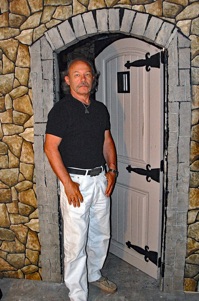
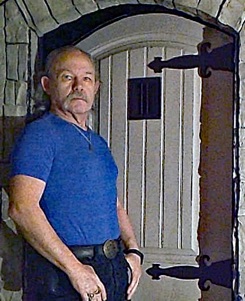

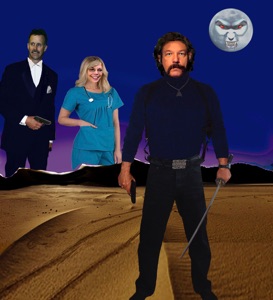
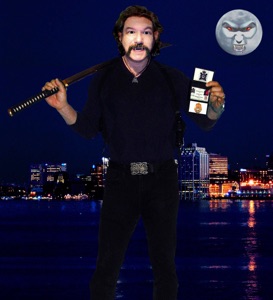
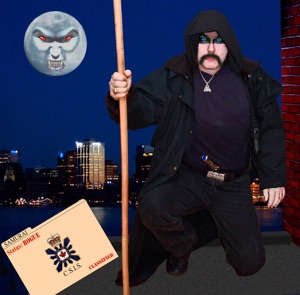
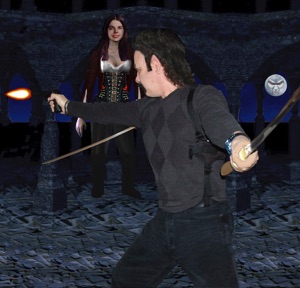
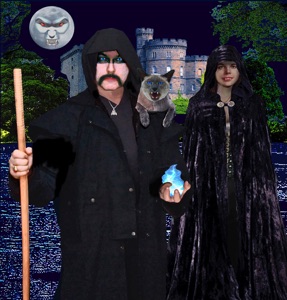
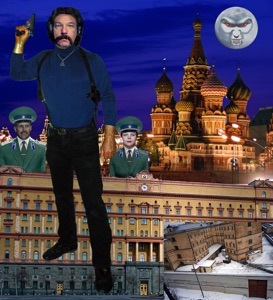


Chūsa: Commander SAMURAI
This one hung in limbo for almost eight years. I started it in 2014, not long after the publication of SHINOBI. Then in the spring of 2015, my MS regressed enough to allow my tone-deafness to disappear (6 Naproxen a day!), and I was focusing on being able to play music, write music, etc.!
Whenever I came back to it, I would start with a major rewrite to get my bearings, adding things, then inching it a little further.
Then COVID happened. In January of 2022, inspiration struck, but it would be a lot of work. I knew how I was going to proceed, but first I had to rewrite yet again, introducing COVID into the story, and advancing the timeline by almost eight years.
I wanted to add indigenous characters, and I wasn’t through with Colonel Ilya Kalugin, either. I had to come up with a feasible way of breaking him out of HMP Belmarsh, the UK’s Secure-Max facility for terrorists, security-risk prisoners — where MI5 would have put him.
I also wanted to revisit Michael’s relationship with Myrddin (Merlin), and how Michael’s powers, both vampiric and Wiccan Magick, might have advanced in the years since a major infusion of Merlin’s blood into his system.
Second draft is finished, coming in at 348 pages. s
